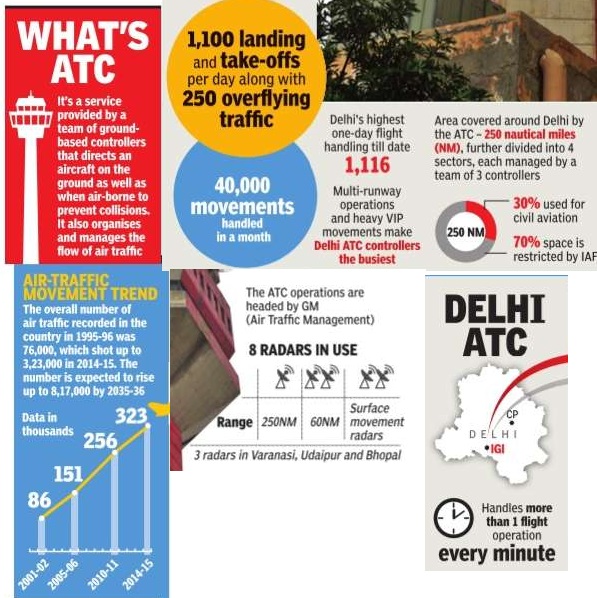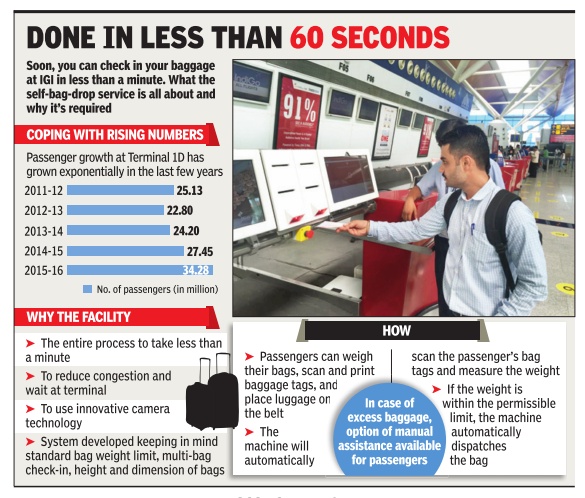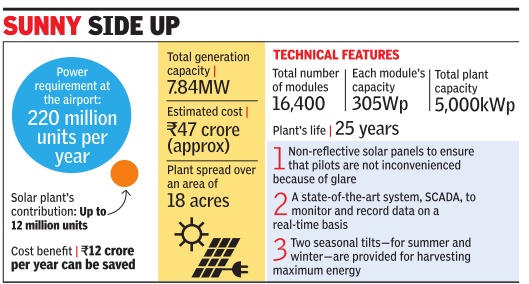Indira Gandhi International (IGI) Airport, Delhi
(→Services) |
(→2015: Among best On-Time Performers) |
||
| Line 37: | Line 37: | ||
“CDM is all about the airport and aircraft operators, ground handlers and the ATC working together more efficiently and transparently . One of the main outputs of CDM will be more accurate `Target Take Off Times' which can be used to improve air traffic movements even during foggy days. Even if arrival OTP is bad, the airport will be helping flights meet the departure OTP,“ said Marcel Hungerbuehler, chief operating officer of DIAL. | “CDM is all about the airport and aircraft operators, ground handlers and the ATC working together more efficiently and transparently . One of the main outputs of CDM will be more accurate `Target Take Off Times' which can be used to improve air traffic movements even during foggy days. Even if arrival OTP is bad, the airport will be helping flights meet the departure OTP,“ said Marcel Hungerbuehler, chief operating officer of DIAL. | ||
| + | |||
| + | =In the global list of 15 busiest airports/ 2016= | ||
| + | [http://epaperbeta.timesofindia.com/Article.aspx?eid=31808&articlexml=IGI-enters-global-list-of-15-busiest-airports-13022017006008 IGI enters global list of 15 busiest airports in Nov 2016, Feb 13 2017: The Times of India] | ||
| + | |||
| + | Indira Gandhi International (IGI) airport became the 12th busiest airport worldwide for the month of November 2016 as per the report released by the International Civil Aviation Organisation (ICAO). | ||
| + | |||
| + | This was the first time an Indian airport entered the big league of top 15 airports in the world. Delhi airport also recorded the highest growth rate of 19.1% in November 2016 globally , the report said. | ||
| + | |||
| + | IGI airport crossed the 50 million passenger mark during the same period in November. Last year, Delhi airport handled a record 55.64 million passengers -the highest ever in the country. | ||
| + | |||
| + | IGI airport also reached an average of 1,185 air traffic movements a day , which is another record for the country . | ||
| + | |||
=Legal rulings = | =Legal rulings = | ||
==Demurrage charges cannot be levied: HC== | ==Demurrage charges cannot be levied: HC== | ||
Revision as of 00:43, 24 March 2017


This is a collection of articles archived for the excellence of their content. |
Contents |
Performance, international rank
2015: Among best On-Time Performers
The Times of India Dec 21 2015

Anvit Srivastava
New Delhi
For long, the Indira Gandhi International Airport has been called a world-class facility . Now it has added another feather in its cap by being placed among the top 10 performers. Despite its soaring daily flight operations, the airport recorded one of the best On-Time Performance (OTP) parameters in the world for three months in a row.
With the approaching winter, the operator aims to maintain this consistency . To achieve this, the airport Collaborative Decision Making (CMD) has been augmented to improve Air Traffic Flow and Capacity Management (ATFCM) by reducing delays, improving predictability of events and optimising the utilisation of resources.
OTP is recorded when a flight takes off from its originating airport on time and lands at the destination exactly at the scheduled time. According to DIAL, Delhi airport has been among the top 10 airports for best OTP for three consecutive months from July to September, 2015. Even in October the airport recorded one of its best OTPs with do mestic departures scoring 90% on-time performance, while arrivals were recorded at 80%.
At the same time, the international traffic too recorded 80% on-time departures and arrivals 74%. The overall OTP in the month of October remained 88% for departure and 78% for arrival.
A few of the common fac tors that affect on-time performance include late arrival, faults in airline operation, technical problems, connecting crew and apron traffic. This also leads to delay of incoming flights.
Airport sources, however, say that on-time performance is expected to witness a dip with the arrival of the foggy season.
“CDM is all about the airport and aircraft operators, ground handlers and the ATC working together more efficiently and transparently . One of the main outputs of CDM will be more accurate `Target Take Off Times' which can be used to improve air traffic movements even during foggy days. Even if arrival OTP is bad, the airport will be helping flights meet the departure OTP,“ said Marcel Hungerbuehler, chief operating officer of DIAL.
In the global list of 15 busiest airports/ 2016
IGI enters global list of 15 busiest airports in Nov 2016, Feb 13 2017: The Times of India
Indira Gandhi International (IGI) airport became the 12th busiest airport worldwide for the month of November 2016 as per the report released by the International Civil Aviation Organisation (ICAO).
This was the first time an Indian airport entered the big league of top 15 airports in the world. Delhi airport also recorded the highest growth rate of 19.1% in November 2016 globally , the report said.
IGI airport crossed the 50 million passenger mark during the same period in November. Last year, Delhi airport handled a record 55.64 million passengers -the highest ever in the country.
IGI airport also reached an average of 1,185 air traffic movements a day , which is another record for the country .
Legal rulings
Demurrage charges cannot be levied: HC
No holding charges at IGI, says HC, Nov 04 2016 : PTI
Delhi International Airport Ltd (DIAL) cannot levy demurrage charges at the IGI airport, Delhi high court said while rejecting its plea challenging a 2009 regulation which restrains the operators from charging any rent on confiscated goods.
A bench of Justices S Ravindra Bhat and Deepa Sharma dismissed DIAL's petition challenging the regulation 6(1)(1) of the Handling of Cargo in Customs Areas Regulations, 2009.
However, the bench said if DIAL was of the view that direction by custom authorities not to charge demurrage was “unwarranted“, it could seek guidance from the central government.
“In these circumstances, the grievance that regulation 6 can potentially render DIAL's functioning unviable and result in losses to it, has to fail,“ the bench said.
Air traffic control (ATC)
The Times of India, Apr 05 2016


Anvit Srivastava Delhi's ATC is the busiest in country with 1,100 landings and take-offs daily. In peak time, it manages 75 flights an hour. What makes it tick and who are these men with nerves of steel
According to air traffic management officials, better technology in the ATC tower, on the ground infrastructure and in the automated systems helps deal with the drastic increase in the traffic in recent times. But the pressure on the human in the tow er is also higher now. ATC work demands attention every minute. Controllers say that each and every emergency call has to be dealt with equal urgency . “What is routine can suddenly change into something special,“ says one of the controllers. “It could be low holding fuel, low air pressure in a tyre or a medical emergency , but we are the first to know about a special situation on-board a flight and none of them can be dealt with casually .“ As soon as the pilot contacts ATC, the tower ropes in the fire services, and brings AOCC (Airport Operations Control Centre) and DIAL (Delhi International Airport Limited) into the loop.
Work can sometimes be affected by a sudden change in weather, ham pering the controllers' ability to manage the traffic with the same robustness as in better conditions. Apart from sandstorms, high wind velocity and thunder storms, what also up sets the routine are the restrictions caused by VVIP move ment or runway maintenance. “The bur den becomes heavier twofold, threefold, if any of the runways are shut during the peak hours even for five minutes,“ says a controller. “The pile up that this creates takes hours to be cleared. At such times, all of us focus together on clearing the backlog because flight can't backlog because flight can't be held up for too long.“
However, despite their intense work regime and restricted movements in the tower, controllers appreciate the team spirit and the closeness with which they function, especially at tense mo ments. They say that the entire team works like a close-knit family under the supervision of one head, often cracking jokes, pulling the legs of colleagues and sharing special experiences to lighten the work pressure.
Management
The Times of India, Apr 05 2016
3 runways, 8 radars and a dozen pair of eyes
Anvit Srivastava
At the Indira Gandhi International airport, a brigade of air traffic controllers handles 1,100 landings and take-offs every day . In peak time, it manages up to 75 flights an hour. This works out to one flight operation each minute, making the Delhi Air Traffic Control (ATC) station the country's busiest.
“Our aim is to ensure safety of aircraft, maintain regular flow of flights and avoid incidents involving aircraft or passengers,“ says a senior Delhi ATC official. “We have stateof-the-art automation system provided by a USbased firm, which gives us the capacity to manage 75 flight movements per hour on the three runways and two terminals at IGI airport.“ Air traffic at Mumbai is comparably higher, says an official, but IGI is the only airport in the country that employs three runways simultaneously .
The controllers work in five shifts to keep the ATC operational 24x7. Each shift is headed by a Watch Supervisory Officer (WSO), who oversees the functioning of 55 controllers. Over all, Delhi ATC is headed by a general manager, Air Traffic Movement (ATM).
“A team of 11-12 officers sits in the tower managing the landings and take-offs at IGI.The Delhi ATC has jurisdiction over 250 nautical miles. This space is divided in four sectors that are manned by four teams with three members in each,“ explains an official.
“To prevent collisions, ATC enforces traffic separation rules that obligate aircraft to maintain a prescribed minimum unoccupied space around it at all times. Many aircraft also have collision-avoidance systems. These provide additional safety by warning pilots when other aircraft get too close.“
The Delhi ATC uses feeds from eight radars. At IGI airport, there is a long-range instrument called the Air Route Surveillance Radar (ARSR) with the capability of coving the entire 250 nautical miles under Delhi's purview, two short-range radars keeping vigil on 60 nautical miles of territory, and two surface movement radars that manage the ground sur veillance of the runways, apron area, taxiways and bays. Apart from these, the ATC gets feed from three other radars sta tioned at Varanasi, Udaipur and Bhopal for an integrated surveil lance of the entire air space under its jurisdic tion. “ARSR is 15 years old, while one of the short-range radars was only bought last year.
But we ensure regular maintenance of all of them,“ says an official.
Apart from radars, IGI's three runways are also capable of handling landings and take-offs from both ends. Of the six approaches to the runways, three are CAT III-enabled and allow flight operations even at visibility as low as 50 metres. Well-equipped and already at an advanced stage and prepared to handle the rising air traffic, one problem most ATCs face is staff shortage.
Delhi, however, given its status as the busiest in the country , has been spared this problem.
Elsewhere, the long and stress-filled working hours, the necessity of regularly keeping oneself updated with industry developments and low initial salaries keep the youth away from opting for an air traffic controller's job.Despite these challenges, however, controllers testify that the responsibility that comes with the job is rewarding in itself.
Services
2016/ self-bag-drop service
See graphic

Use of solar energy
The Times of India, Apr 13 2016


IGI's triple jump: More solar power to save Rs 12cr per year
Anvit Srivastava Aiming not only to save money , but also to take a stand against global warming, the Indira Gandhi International Airport has tripled its solar power generation capacity to meet a portion of its huge power needs. The green initiative will save the airport Rs 12 crore annually,
More than half of the po wer requirement of Terminal 1D is met by the airport's solar power plant, which became operational in October 2015.
Delhi International Airport Limited (DIAL), which manages the airport, had commissioned a 2.14-Mw plant in January 2014. It has enhanced its generating capacity to 7.84 Mw since. DIAL claims not only financial savings with this measure, but also the status of becoming the first airport in the world to be registered under the Clean Development Mecha nism of the United Nations Framework Convention on Climate Change.
DIAL revealed that internally generated power now constituted 5% of the total power consumption of the airport. To curb the present annual energy bill of over Rs 200 cro re, DIAL aims to raise the generation capacity of the solar power plants to 20 Mw by 2020. I Prabhakara Rao, CEO, DIAL, said the airport currently consumed around 220 million units of power per year, and the plan is to generate 12 million units of solar power every year. “IGI airport has always gi ven the utmost importance to factors affecting the environment,“ said Rao. “We have taken various efficiency measures at Delhi airport, including waste water management system and clean development mechanism.“ The project, which is spread over 18 acres, has so far seen an investment of about Rs 47 crore.
Sujit Nag, executive vicepresident for engineering and projects at DIAL, said that the airport is ideally aligned to make the best use of solar power.“Our panels are south-facing.This helps us make the best use of the solar energy ,“ he said.“The system works on the state-of-art SCADA system to monitor and record daily , real-time data. An independent weather monitoring system to record the parameters in order to validate the plant performance has also been installed.“
Airport officials said the panels of the plant have been constructed in such a way that they have anti-reflective qualities that do not disrupt flight operations. Nag said all steps have been taken in following security measures. The plant has been set up in consultation with security agencies and civil aviation authorities, he said.